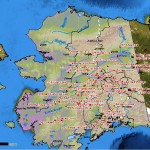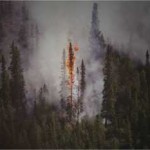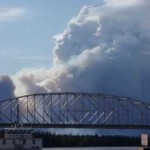Fairbanks is smoky. Anchorage is smoky. To be in Alaska this early June is to see skies of haze, mixed with the scent of burning forests.

Wildfire map June 4, 2010
Because of an unusually dry winter and spring, 293 wildfires already have burned some 463,000 acres according to the Alaska Interagency Coordination Center in Fairbanks. Alaska experienced unprecedented fire activity during May that was more characteristic of extreme July conditions, the center noted. Most of the wildfires are lightning-caused, and are located southeast and west of Fairbanks.
Persistent heat and a lack of rain have been rampant in interior Alaska over the past two weeks.
 In Fairbanks, high temperatures have averaged more than 11 degrees F above normal in that time, while it has received only 40 percent of its normal May precipitation.
In Fairbanks, high temperatures have averaged more than 11 degrees F above normal in that time, while it has received only 40 percent of its normal May precipitation.
Highs in Anchorage have also been above normal, averaging over 10 degrees F during the past week. Only 26 percent of typical precipitation for May has occurred in Anchorage.
Firefighters from the Pacific Northwest have been streaming into Alaska to help with the fires. More than 30 employees of the Washington State Department of Natural Resources (DNR) are in Alaska this week helping crews there deal with an outbreak of large wildfires that have consumed more than 270,000 acres.
Responding to a mutual aid request last week, DNR employees began arriving in Alaska over the Memorial Day weekend.
“We are pleased to help our neighbor to the north in their time of need without diminishing our capacity to respond quickly to wildfire threats here in Washington State,” said Commissioner of Public Lands Peter Goldmark.

Fairbanks, June 2, 2010
Forecasters expect that burn acreage to exceed 900,000 by the end of June.
Parts of the desert Southwest, Alaska, northern Great Lakes and Gulf Coast are facing above-normal chances of significant wildfires this month, a federal agency says.
A forecast Tuesday by the National Interagency Fire Center, and reported by USA Today, also warned of increased fire risk later this summer for parts of Northern California and Nevada; a large area of northern Idaho, western Montana and Wyoming; and parts of eastern Washington state.
“That area had low snowpack this winter,” said Rick Ochoa, national fire weather program manager for the federal center’s predictive services. “We’re anticipating a hotter-and-drier-than-normal summer … so we anticipate we’ll see a potentially active fire season in that area.”
CITATIONS:
Wildfires likely to flare in U.S. hot spots
USA Today, June 4, 2010
New wildfire warnings in effect for Interior Alaska
Fairbanks Daily News-Miner, June 4, 2010
Wildfires Wreak Havoc in Alaska, Southeastern Canada
AccuWeather, June 1, 2010
Southern Oregon firefighters battle Alaska blazes
Southern Oregon Mail Tribune, June 4, 2010
Cooler weather doesn’t slow spread of Alaska wildfires
Anchorage Daily News, June 4, 2010
Since it is now out of “fashion” to do control burns to prevent massive wildfires, I expect nature to take over and create huge wild fires.
As usual those whose refuse to learn from history are doomed to repeat it. Unfortunately those who pushed the idiotic changes banning controlled burns will not suffer because it is not THEIR homes and bodies that end up getting burned.
Too bad they are not the ones who have to suffer from their stupidity.
I remember in 1976 visiting near Fairbanks Alaska I meet a guy that had a bulldozer sticking out the the ground on his land.
All you could see was the exhaust stack and roll cage. He explained that there had been a Permafrost fire burning for years underground. When the fire moved through his land, it melted the permafrost and sank his bulldozer. Living in a very rural area he had no way to get it out. I would bet it’s still there.
You can’t put out a permafrost fire, they